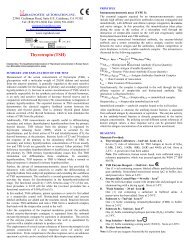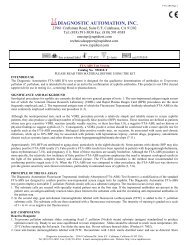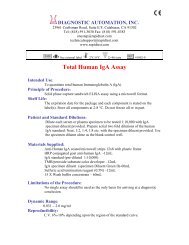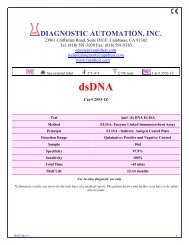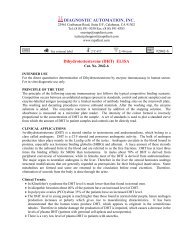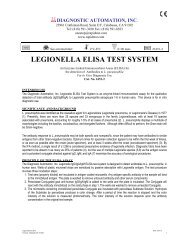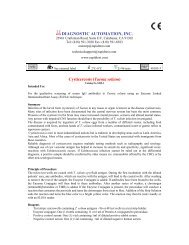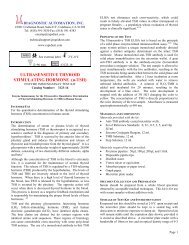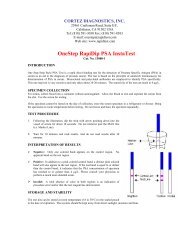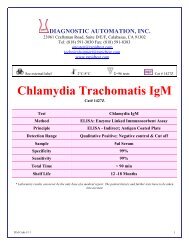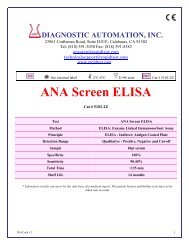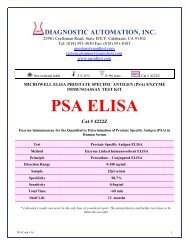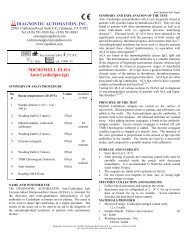MDMA (Ecstasy, XTC) - Diagnostic Automation : Cortez Diagnostics
MDMA (Ecstasy, XTC) - Diagnostic Automation : Cortez Diagnostics
MDMA (Ecstasy, XTC) - Diagnostic Automation : Cortez Diagnostics
- No tags were found...
You also want an ePaper? Increase the reach of your titles
YUMPU automatically turns print PDFs into web optimized ePapers that Google loves.
<strong>MDMA</strong> (<strong>Ecstasy</strong>, <strong>XTC</strong>) RapiCard InstaTest<br />
ONE STEP ASSAY<br />
RAPID VISUAL RESULTS<br />
FOR QUALITATIVE IN VITRO DIAGNOSTIC USE<br />
Cat. No. 121030-1<br />
INTENDED USE<br />
This device is a one-step immunoassay intended to provide qualitative rapid<br />
detection of methylenedioxymethamphetamine (<strong>MDMA</strong>, <strong>Ecstasy</strong>, or <strong>XTC</strong>) in<br />
human urine at a cut-off concentration of 500ng/ml. It is for health care<br />
professional use only.<br />
This test provides only a preliminary analytical test result. A more specific alternate<br />
chemical method must be used in order to obtain a confirmed analytical result. Gas<br />
Chromatography/Mass Spectrometry (GC/MS) is the preferred confirmatory method.<br />
Clinical consideration and professional judgment should be applied to any drug of<br />
abuse test result, particularly when preliminary positive results are used.<br />
SUMMARY AND EXPLANATION OF THE TEST<br />
<strong>MDMA</strong> is an abbreviation for the chemical methylenedioxymethamphetamine. It<br />
has street many name including <strong>Ecstasy</strong>, X, <strong>XTC</strong>, E, Love Doves, Clarity, Adam,<br />
Disco Biscuits and Shamrocks, etc. It is a stimulant with hallucinogenic tendencies,<br />
described as an empathogen as it releases mood-altering chemicals, such as<br />
cartooning and L-dopa, in the brain and may generate feelings of love and<br />
friendliness. <strong>MDMA</strong> is a Class A drug, in the same category as heroin and cocaine.<br />
The adverse effects of <strong>MDMA</strong> use include elevated blood pressure, hyperthermia,<br />
anxiety, paranoia, and insomnia. Overdoses of <strong>MDMA</strong> can be fatal, often resulting in<br />
heart failure or heat stroke. 1,2<br />
<strong>MDMA</strong> belongs to a family of man-made drugs; its relatives include MDA<br />
(methylenedioxyamphetamine), the parent drug of <strong>MDMA</strong>, and MDEA<br />
(methylenedioxyethylamphetamine), also know as EVE. They all share the<br />
amphetamine-like effects. <strong>MDMA</strong> is administered either by oral ingestion or<br />
intravenous injection. <strong>MDMA</strong> tablets come in different sizes and colors, and often<br />
have logos such as doves on them. Its clinical dose is 50-100mg; the threshold toxic<br />
dose is 500mg. The effects of <strong>MDMA</strong> begin 30 minutes after intake. They peak in an<br />
hour and last for 2-3 hours. Sixty five percent (65%) of <strong>MDMA</strong> is excreted<br />
unchanged in urine: it is detectible in the urine for up to 3 days after use. 1,2<br />
SPECIMEN COLLECTION<br />
1. Each urine specimen must be collected in a clean container.<br />
2. Specimens may be kept at room temperature for 8 hours, at 2-8°C for up to 3<br />
days and at -20°C or lower for prolonged storage. Do not mix specimens.<br />
PRECAUTION<br />
1. The instructions must be followed to obtain accurate results.<br />
2. Do not open the sealed pouch, unless ready to operate the assay.<br />
3. Dispose of all specimens and used assay materials in a proper biohazard<br />
container.<br />
4. Do not use expired devices.<br />
ASSAY PROCEDURE<br />
1. Refrigerated specimens or other materials must be equilibrated to room<br />
temperature before testing.<br />
2. Remove the test device from pouch and place it on a flat surface. Label the<br />
device with specimen identification.<br />
3. Holding the dropper vertically, add four drops (about 160∝l) of the specimen<br />
to the sample well marked as "S" on the device.<br />
Note: If migration is not observed in 30 seconds in the results window, add<br />
one or two extra drops of urine specimen.<br />
4. Read the test result between four (4) to seven (7) minutes after adding the<br />
specimen.<br />
IMPORTANT: Do not read test results after seven (7) minutes.<br />
INTERPRETATION OF RESULTS<br />
POSITIVE: Only the C line appears in the viewing window.<br />
Note: Samples with positive results should be confirmed with a more specific<br />
method before a positive determination is made.<br />
Control (C) Line Test (T) Line Sample Well<br />
C<br />
T<br />
PRINCIPLE OF THE PROCEDURE<br />
This assay is a one-step lateral flow chromatographic immunoassay. The test strip<br />
includes 1) a burgundy-colored conjugate pad containing mouse anti-<strong>MDMA</strong><br />
antibody coupled to colloidal gold, and 2) nitrocellulose membrane containing a T<br />
line and a C line. The T line is coated with <strong>MDMA</strong>-BSA, and the C line is coated<br />
with goat anti-mouse antibody.<br />
This test is a competitive binding immunoassay. The <strong>MDMA</strong> in the urine specimen<br />
competes with the <strong>MDMA</strong>-BSA on the membrane for the limited binding sites of<br />
the anti-<strong>MDMA</strong> antibodies in the conjugate pad.<br />
When an adequate amount of urine specimen is applied onto the sample pad of the<br />
device, the urine migrates by capillary action through the test strip. If the level of<br />
<strong>MDMA</strong> in the urine specimen is below the cutoff (500ng/ml), the T line should<br />
appear as a solid burgundy line. If the level of <strong>MDMA</strong> in the urine specimen is<br />
above the cutoff, the T line should not develop within the reading time of the<br />
device, 7 minutes.<br />
The C line should bind to the colored mouse antibody conjugate and form a<br />
burgundy colored line regardless of the presence of <strong>MDMA</strong>.<br />
REAGENTS AND MATERIALS SUPPLIED<br />
1. 25 test devices, each in a pouch with a dropper pipette and desiccant.<br />
NEGATIVE: Both C line and T line appear in the viewing window.<br />
Note: A faint line in the test region should be considered negative.<br />
Control (C) Line Test (T) Line Sample Well<br />
C<br />
INVALID: If no C line develops within 5 minutes, repeat the assay with a new test<br />
device.<br />
T<br />
Control (C) Line Test (T) Line Sample Well<br />
2. One package insert<br />
MATERIAL REQUIRED BUT NOT PROVIDED<br />
C<br />
T<br />
1. Specimen collection containers<br />
2. Timer<br />
3. Positive and Negative standards<br />
Control (C) Line Test (T) Line Sample Well<br />
STORAGE AND STABILITY<br />
Store the kit at room temperature 59-86°F (15-30°C). Each device may be used<br />
until the expiration date printed on the label if it remains sealed in its foil pouch<br />
containing desiccant.<br />
Do not freeze the kit and/or expose the kit to the temperature over 30°C.<br />
C<br />
T
<strong>MDMA</strong> (<strong>Ecstasy</strong>, <strong>XTC</strong>)RapiCard InstaTest<br />
QUALITY CONTROL<br />
Built-in Control Features<br />
This test contains a built-in control feature, the C line. The presence of the C<br />
line indicates that the proper sample volume was used and that the reagents<br />
migrated properly. If a C line does not form, the test is considered invalid. In<br />
this case, review the whole procedure and repeat the testing with a new device.<br />
External Quality Control<br />
Users should always follow the appropriate federal, state, and local guidelines<br />
concerning the running of external quality controls. SAMHSA recommends<br />
that the concentration of drug(s) in positive and negative controls be<br />
approximately 25% above and below the cutoff concentration of the assay.<br />
LIMITATIONS<br />
1. There is a possibility that other substances and/or factors not listed in this<br />
instruction may interfere with the test and cause false results, e.g., technical<br />
or procedural errors.<br />
2. Some adulterants such as bleach or other strong oxidizing agents may<br />
produce erroneous test results if added in the device. When suspected, collect a<br />
fresh specimen and repeat the test with a new device.<br />
EXPECTED VALUES<br />
This test is designed to detect the <strong>MDMA</strong> in human urine at a cutoff concentration of<br />
500 ng/ml.<br />
PERFORMANCE CHARACTERISTICS<br />
1. Accuracy<br />
One hundred ten (110) <strong>MDMA</strong>-spiked urine specimens calibrated with<br />
GC/MS method were used for the accuracy studies on this device. Among<br />
the 110 specimens, there were 55 negative and 55 positive. Within the<br />
negative specimens, 15 were negative (without <strong>MDMA</strong>), 15 were 50% below<br />
cutoff (257ng/ml <strong>MDMA</strong>), and 25 were 25% below cutoff (378ng/ml).<br />
Within the positive specimens, 25 were 25% above cutoff (615ng/ml), 15<br />
were 50% above cutoff (709ng/ml), and 15 were positive (1417ng/ml). Studies<br />
were carried out in a clinical reference laboratory and three (3)<br />
Physician’s Office Laboratories (POL) by personnel with diverse educational<br />
backgrounds and working experiences.<br />
The results obtained from this <strong>MDMA</strong> Urine Test were 57 negative and 53<br />
positive. The negative results agreed 100 % (55/55). The positive results<br />
agreed 96.4 % (53/55). The two (2) discrepancies were within the range of<br />
25% above the cutoff level (615ng/ml). The correlation of the results<br />
obtained from the four evaluation sites was 98%.<br />
2. Precision<br />
<strong>MDMA</strong> Test<br />
negative positive Total<br />
GC/MS negative (500ng/ml) 2 53 55<br />
Total 57 53 110<br />
The precision was determined by replicate assays of four different levels of<br />
samples with three different production lots. The devices were tested for five<br />
consecutive days five times each, for a total of 25 assays for each control.<br />
The results obtained indicate 100% precision for the replicate within each lot<br />
and no appreciable inter-lot variation across the three different lots of devices.<br />
3. Cross-Reactivity<br />
The cross-reactivity of the structurally related compounds with the device was<br />
studied. The following compounds were spiked into known drug-free urine<br />
pools and tested with the <strong>MDMA</strong> Urine Test.<br />
Compounds produced positive responses at a concentration below 10∝g/ml<br />
were indicated in the following table:<br />
Description<br />
Concentration (ng/ml)<br />
methylenedioxyampphetamine (MDA) 2000<br />
methylenedioxyethylamphetamine(MDEA) 1000<br />
Compounds did not produce positive results at a concentration below<br />
100∝g/ml were indicated in the following table:<br />
Description<br />
Concentration(∝g/ml)<br />
L-amphetamine 100<br />
d-amphetamine 100<br />
L-methamphetamine 100<br />
d-methamphetamine 100<br />
Hydroxymethamphetamine (HAM) 100<br />
Dihydroxymethamphetamine (HMMA) 100<br />
N-methyl-1-(1-3-benzodioxol-5-yl)-2-<br />
100<br />
butanamine(MBDB)<br />
4. Interference<br />
The following structurally unrelated analytes were spiked into known drugfree<br />
urine pools, as well as the <strong>MDMA</strong> positive (500ng/ml) urine pools and<br />
were tested with the <strong>MDMA</strong> one step Urine Test. No interference was<br />
observed with either negative or positive specimens.<br />
Compound Conc. Compound Conc.<br />
Acetaminophen 100 ∝g/ml Oxazepem 100 ∝g/ml<br />
Acetylsalicylic Acid 100 ∝g/ml Penicillin-G 100 ∝g/ml<br />
Amikacin 100 ∝g/ml Propoxyphene 100 ∝g/ml<br />
Amitriptyline 100 ∝g/ml Pheniramine 100 ∝g/ml<br />
Ampicillin 100 ∝g/ml Phencyclidine 100 ∝g/ml<br />
Arterenal 100 ∝g/ml Phenylpropanalamine 100 ∝g/ml<br />
Atropine 100 ∝g/ml Ranitidine 100 ∝g/ml<br />
Benzoic Acid 100 ∝g/ml Secobarbital 100 ∝g/ml<br />
Benzoylecgonine 100 ∝g/ml Salicylic Acid 100 ∝g/ml<br />
Caffeine 100 ∝g/ml 11-nor- 9 -THC-9-COOH 100 ∝g/ml<br />
(+)-Chlorpheniramine 100 ∝g/ml Thioridazine 100 ∝g/ml<br />
(+/-)-Chlorpheniramine 100 ∝g/ml Trifluoperazine 100 ∝g/ml<br />
Cocaine 100 ∝g/ml Albumin 200 ∝g/ml<br />
Codeine 100 ∝g/ml Bilirubin 100 ∝g/ml<br />
Cortisone 100 ∝g/ml Creatine 100 ∝g/ml<br />
Dextromethorphan 100 ∝g/ml Glucose 100 ∝g/ml<br />
Methadone 100 ∝g/ml Hemoglobin 200 ∝g/ml<br />
Morphine 100 ∝g/ml PH 5.0-9.0<br />
Morphine-3-b-D-glucuronide 100 ∝g/ml Vitamin C 100 ∝g/ml<br />
Nortriptyline 100 ∝g/ml Uric Acid 100 ∝g/ml<br />
Oxalic Acid<br />
100 ∝g/ml<br />
There is a possibility that other substances and/or factors not listed above may<br />
interfere with the test and cause false results.<br />
REFERENCES<br />
1. S-J. Peroutka ed. <strong>Ecstasy</strong>: The clinical, pharmacological and<br />
neurotoxicological effects of the drug <strong>MDMA</strong>. Kluwer Academic<br />
Publishers, 1990.<br />
2. Wilson, John, Abused Drugs II, a Laboratory Pocket Guide., AACC<br />
Press. Washington, DC; p52, 1994.<br />
Revision Date: 4/4/06<br />
CORTEZ DIAGNOSTICS, INC.<br />
23961 Craftsman Road, Suite E/F,<br />
Calabasas, CA 91302 USA<br />
Tel: (818) 591-3030 Fax: (818) 591-8383<br />
E-mail: onestep@rapidtest.com<br />
Web site: www.rapidtest.com<br />
See external label 2°C-30°C Σ=25 or 50 tests



